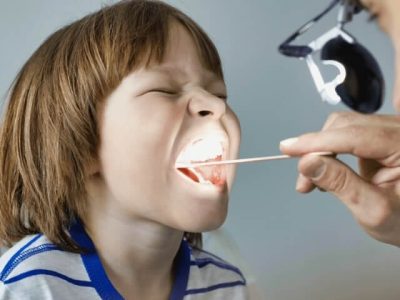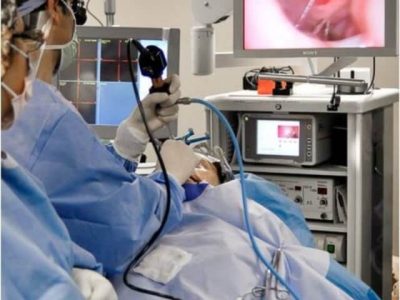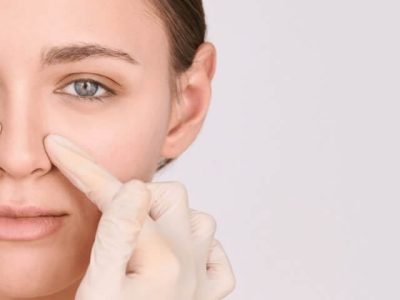What Is Nasal Turbinate Hypertrophy?
Nasal turbinate hypertrophy refers to the abnormal enlargement or swelling of the turbinates inside the nose. Turbinates (or nasal conchae) are curved bony structures covered by a vascular, mucous‐membrane lining. They help with:
- Warming, humidifying, filtering the incoming air
- Regulating airflow
- Trapping particles, allergens, and pathogens
Usually, there are three sets of turbinates on each side: superior, middle, and inferior. Occasionally, a fourth (supreme) may be present. The inferior turbinates are the largest and most often involved in hypertrophy because much of the nasal airflow passes alongside them.
Hypertrophy means that either the bone, the soft tissue (mucosa), or both have increased in size. This can be a chronic (long‐term) or acute (short‐term) problem
Causes of Turbinate Hypertrophy (Why Turbinates Enlarge)
Multiple factors can trigger or exacerbate turbinate hypertrophy. Some are physiological (normal), others pathological.
- Allergic Rhinitis
Repeated exposure to allergens (pollen, dust mites, pet dander, mold) causes chronic inflammation of the nasal lining. The mucosa becomes swollen, blood vessels dilate, and turbinates enlarge. - Non-Allergic / Vasomotor Rhinitis
Environmental irritants (air pollution, chemicals, smoke), abrupt temperature changes, strong odors, humidity, stress can all trigger similar inflammation without an allergic immune response. The turbinates swell in response. - Chronic Sinusitis and Upper Respiratory Infections
Repeated or persistent sinus infections lead to inflammation and sometimes thickening of mucosa. This can increase turbinate size. - Structural or Anatomical Factors
- Deviated nasal septum: when the septum is crooked, airflow becomes turbulent on the opposite side, which can chronically irritate and enlarge the opposing turbinate.
- Concha bullosa: a pneumatized (air-filled) middle turbinate which can take up space and block air flow or drainage.
- Hormonal Changes & Medical Conditions
Pregnancy (due to hormonal and vascular changes), thyroid disease, diabetes, or other systemic conditions can contribute to mucosal swelling. - Medication‐induced / Overuse of Decongestants
Prolonged use of topical nasal decongestant sprays may cause rebound swelling (rhinitis medicamentosa), worsening turbinate hypertrophy. Some systemic medications can have side effects that include nasal congestion.
Symptoms of Turbinate Hypertrophy
The symptoms vary depending on severity, whether one or both sides are affected, whether sleep is disturbed, etc. Common symptoms include:
- Persistent nasal congestion or nasal blockage (one side or both)
- Difficulty breathing through the nose, often with alternating sides
- Mouth breathing, especially during sleep, leading to dry mouth, sore throat
- Snoring, sleep disturbance, and possibly sleep apnea due to obstruction
- Postnasal drip (mucus dripping down throat), nasal drainage
- Reduced sense of smell (hyposmia) or altered sense of smell in some cases
- Facial pressure, headache, sinus pain, fatigue (especially if sinusitis is co-present)
Diagnosis of Turbinate Hypertrophy
To confirm the diagnosis and determine the best treatment, ENT doctors will use a combination of:
- History and Physical Examination
- Asking about duration of symptoms, triggers, allergy history, medications, prior surgeries.
- Visual exam inside nose, sometimes with nasal speculum or other tools.
- Nasal Endoscopy
- A flexible or rigid endoscope allows visualization of turbinates (inferior, middle), septum, sinus drainage points, presence of inflammation, polyps, concha bullosa.
- Imaging (CT Scan / Sinus CT)
- If sinus disease is suspected or to assess the structures (bone, possible anatomical variations). Helps in ruling out contributing factors.
- Allergy Testing
- Skin tests or blood tests to determine allergic vs non-allergic causes.
- Evaluation of Other Contributing Conditions
- Check for deviated septum, nasal valve collapse, polyps, systemic conditions.
Treatment Options for Nasal Turbinate Hypertrophy
Treatment is tailored to the cause, severity, patient preference, and whether other nasal or sinus disease is present. They fall into two major categories: non-surgical (medical / conservative) and surgical / procedural.
Non-Surgical / Medical / Conservative Management
Often the first line especially when symptoms are mild-to-moderate, intermittent, or when patient prefers less aggressive treatment.
| Treatment | What It Does / When to Use | Pros / Considerations |
|---|---|---|
| Nasal corticosteroid sprays | Reduces mucosal inflammation, swelling over weeks to months. Very effective in allergic rhinitis and chronic rhinitis. | Safe for long-term use when used properly. Needs consistent use. Possible side effects (local dryness, irritation). |
| Antihistamines (oral or nasal) | Helps if allergies are the trigger; reduces histamine-mediated swelling. | Oral antihistamines may have systemic side effects (drowsiness). Nasal antihistamines can act faster locally. |
| Decongestants | Short-term relief of nasal blockage by vasoconstriction. Useful in acute flareups. | Should not be used long term (>3-5 days) due to risk of rebound and worsened congestion (rhinitis medicamentosa). |
| Nasal saline irrigation | Helps flush allergens, mucus, irritants; keeps nasal passages humidified. | Safe, and can be done at home. Needs proper technique and clean water. |
| Allergen avoidance | Reducing exposure to triggers (pets, dust, mold, pollen, smoke) can reduce chronic swelling. | Sometimes difficult and lifestyle changes may be required. |
| Allergy immunotherapy | For patients with confirmed allergies who do not respond fully to meds; aims to reduce sensitivity to allergens. | Takes time (months to years), may require injections or sublingual therapies. |
Surgical / Procedural Treatments
When medical therapy fails, or if turbinate hypertrophy is very severe, or contributing to sleep apnea or frequent sinus disease, ENT specialists may recommend procedures or surgery.
Here are some of the surgical / procedural options:
| Procedure / Technique | Description | Benefits & Risks |
|---|---|---|
| Inferior Turbinate Reduction / Turbinoplasty | Reduction in size of inferior turbinate either by removing portion of bone/soft tissue or reshaping. Techniques include submucosal resection, partial turbinectomy, etc. | Improves airflow; if done carefully, preserves mucosal lining. Risks include bleeding, crusting, pain. Over-resection risk leads to complications like empty nose syndrome. |
| Radiofrequency Ablation | Minimally invasive; uses heat to shrink the turbinate tissue under mucosa. Often done under local anesthesia. | Less post‐op pain, shorter recovery, lower risk; may require repeated treatments. |
| Coblation / Electrocautery / Diathermy | Use of low-temperature plasma or electric current to reduce soft tissue. | Less invasive; less bleeding; good for patients who want outpatient or office-based procedure. |
| Endoscopic Sinus Surgery | If hypertrophy is part of broader sinus disease, or there are anatomical issue(s) (polyps, concha bullosa, septal deviation), surgery may address multiple problems in one. | Can give large improvement; longer recovery; more risk than in-office procedures. |
| Submucosal Resection | Removes bone and enlarged submucosa but preserves outer mucosal layer; good balance between size reduction and function preservation. |
Potential Risks / Complications & Patient Considerations
- Empty Nose Syndrome (ENS): Rare but serious. Over-aggressive removal of turbinate tissue can lead to loss of normal mucosa, abnormal airflow sensation (still feeling congested despite open nasal airway), crusting, dryness.
- Bleeding, swelling, infection after surgery or procedural intervention.
- Recurrence of hypertrophy: If underlying cause (allergies, irritants, sinus disease) isn’t managed, the turbinates can re-enlarge.
- Recovery time depends on procedure: in-office, minimally invasive options recover faster; major surgery requires more care.
Post-Procedure / Surgery Care & Follow-Up
To get the best outcome after any surgical or procedural intervention:
- Regular follow-up with an ENT specialist to monitor healing, check for infection, and ensure that airway is improving.
- Saline rinses / sprays: Help keep the nose moist, reduce crusting, clear debris.
- Avoid irritants: Smoking, exposure to polluted air, allergens, harsh chemicals.
- Continue management of contributing conditions: Allergies, sinus infections, deviated septum, reflux.
- Sleep hygiene: For those with sleep apnea or snoring, consider CPAP if prescribed, proper sleep posture, etc.
How to Choose the Right Treatment Path
- Severity of symptoms: mild congestion vs daily breathing difficulty or sleep disturbances.
- Duration: Is the hypertrophy recent and possibly reversible, or long‐standing and structural?
- Cause(s): Allergic vs non-allergic vs anatomical.
- Patient preference: Some may avoid surgery; others willing to have a more permanent fix.
- Cost, access to specialists, local resources.
Prognosis and Outlook
With proper diagnosis and treatment, many patients enjoy significant relief in nasal airflow, reduction in congestion, improved sleep, fewer sinus infections. For cases managed with medical therapy alone, steady improvement may take weeks. Procedural or surgical treatments tend to offer faster and more dramatic improvements, though they come with higher upfront risks and recovery needs.
Without treatment, hypertrophy can worsen, causing chronic obstruction, worsening sleep quality, possibly contributing to long-term problems (e.g. pulmonary effects of mouth breathing, exacerbation of sleep apnea, etc.).
FAQs (Frequently Asked Questions)
Q: Can nasal congestion from turbinate hypertrophy go away without surgery?
Yes, especially if it’s caused by allergies or irritants. With good medical management, environmental control, and consistent treatment (steroids, antihistamines), many people improve significantly.
Q: How long do nasal steroid sprays take to work?
Usually several days to weeks; maximal effect often after 2–3 weeks of regular use.
Q: Are in-office procedures effective?
Yes. Radiofrequency ablation, coblation, and other minimally invasive methods can be quite effective with lower risk and faster recovery than more aggressive surgery.
Q: Is surgery painful?
There may be discomfort, swelling, crusting, sometimes bleeding. But many newer methods are done under local anesthesia with minimal pain, and most patients return to normal activities in a few days up to a week, depending on the procedure.
Q: Could turbinate surgery make breathing worse?
If too much turbinate tissue is removed (especially mucosa), there is risk of empty nose syndrome, which can paradoxically worsen symptoms despite a more open airway. Choosing a skilled ENT and conservative approach helps reduce risks.
Nasal turbinate hypertrophy is a common cause of nasal congestion, nasal obstruction, snoring, sleep disturbance, and sinus disease. It can be triggered by allergies, infections, hormonal changes, structural issues like deviated septum, or environmental irritants. Diagnosis involves history, physical exam, endoscopy, sometimes imaging and allergy testing. Treatments range from medical (steroids, antihistamines, saline, lifestyle changes) to minimally invasive procedures and surgery. Outcomes are generally good with correct treatment and proper patient follow-up.






